From public transportation systems to rural walking trails, how public art transforms our daily commute
Whether we drive, bike, or hop on public transit, most of us spend a significant portion of our day on the road, getting from one point to another. While time on the road might feel uneventful and intermediate, public art can bring colour and excitement to even the most mundane voyages, reflecting the rich communities that we pass through on our way.
How do we turn the trodden path into a gallery of its own? Take a journey along these five stops to discover the many ways we can integrate public art into our daily commutes.
This feature is part of Fieldnotes, a public art blog series by STEPS that promotes inclusive and innovative public art through interviews, storytelling, case studies, and knowledge sharing.
From the Streets: Asphalt Art
Putting the “street” in street art, asphalt art projects are a creative and affordable way to enliven the city using an unconventional canvas. Transforming an ordinary drive into an art experience, the street is a unique and underutilized venue for expressing the cultural character of a city.
Apart from the aesthetic value, thoughtfully planned road art can also be beneficial to traffic safety. According to a 2022 safety study by the Asphalt Art Initiative, a funding body for public art on roadways and pedestrian spaces, asphalt art correlates with a variety of pedestrian and driver safety benefits. For example, art on unsignaled intersections saw an increase in drivers yielding to pedestrians. Asphalt art on the borders of streets also visually narrows traffic lanes, which can improve traffic safety by encouraging slower driving.
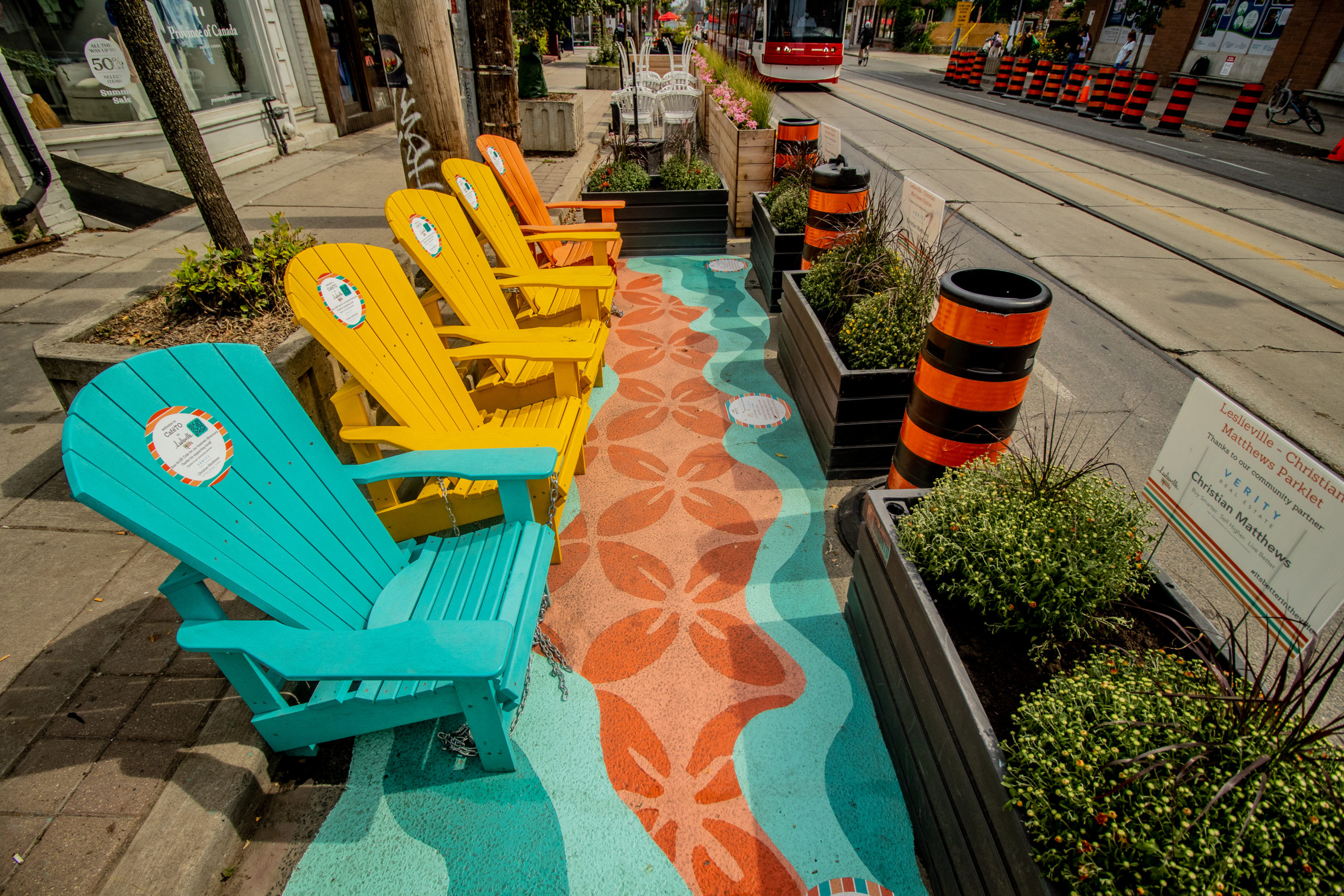
Parkettes in Toronto’s Leslieville transform parking lanes into outdoor public spaces to facilitate COVID-19 social distancing
Artist Credit: Gabrielle Lasporte
Photo Credit: Selina McCallum
Asphalt art can even transform roads into novel locales, creating new third spaces for community members to gather and spend leisure time. In Toronto’s Leslieville BIA, as part of the 2021 edition of STEPS’ I HeART Main Street series, vivid ground murals animate parkettes—also known as parklets, permanent or temporary sidewalk extensions that expand the space and amenities available to pedestrians, creating a more walker-friendly street. Visually shifting the arrangement of the street, these murals can show us that the streets don’t have to be asphalt-grey.
The Next Stop: Animating Public Transit Stations
From subway stations to bus interchanges, urban public transportation hubs are nexuses of the crossing paths that make up city life. While most people move through these spaces as if on autopilot, only paying attention to tap through the turnstile or find the escalator, a closer look around might reveal an artistic gem.

Wrapping around the entrance of Toronto’s Finch subway station, Crossroads blends cultural motifs into a diverse tapestry
Artist Credit: Kseniya Tsoy
Photo Credit: Jae Yang
As the heart of these intersecting and connecting passages through the city, the public transit hub should be a platform for public art that celebrates the richness of the local culture. For STEPS, art in transit means translating the stories of residents through community-engaged art. Crossroads, a community-engaged mural led by Kseniya Tsoy, is a project that exemplifies this representation of local stories and heritage, animating Toronto’s Finch Transportation Hub.
With design input from members of Toronto’s Willowdale neighbourhood, Crossroads takes inspiration from cultural myths, legends, and folk motifs from around the world. According to Kseniya, Crossroads is a “legacy mural and woven of the community’s diverse experiences–a collective expression of our diverse lineages, traditions and histories.”
Apart from our heritage and histories, public art in transit can explore human relationships with the world around us. In 2020, STEPS collaborated with FLAP Canada to combine community engagement with participatory arts for the 2021 project Safe Flight Home by artist Fatspatrol, a series of temporary vinyl murals at three Toronto Line 1 subway stations. Apart from their aesthetic value, these murals served an ecological purpose: embellishing the glass panels of the station improved its visibility to passing birds, preventing avian collisions just in time for migration season.
Video Credit: May Shi
Through a series of online workshops, Fatspatrol taught mark-making techniques and engaged community members in conversations about conservation. For the artist, this was a chance to have vital conversations about human relationships to the environment, especially during the COVID-19 pandemic: “Speaking about freedom of movement, resilience, vulnerability, connection and hope within the context of our experience of the last year put a spotlight on the impact of human intervention on the natural world.”
Art on Wheels: Riding the Bus Gallery
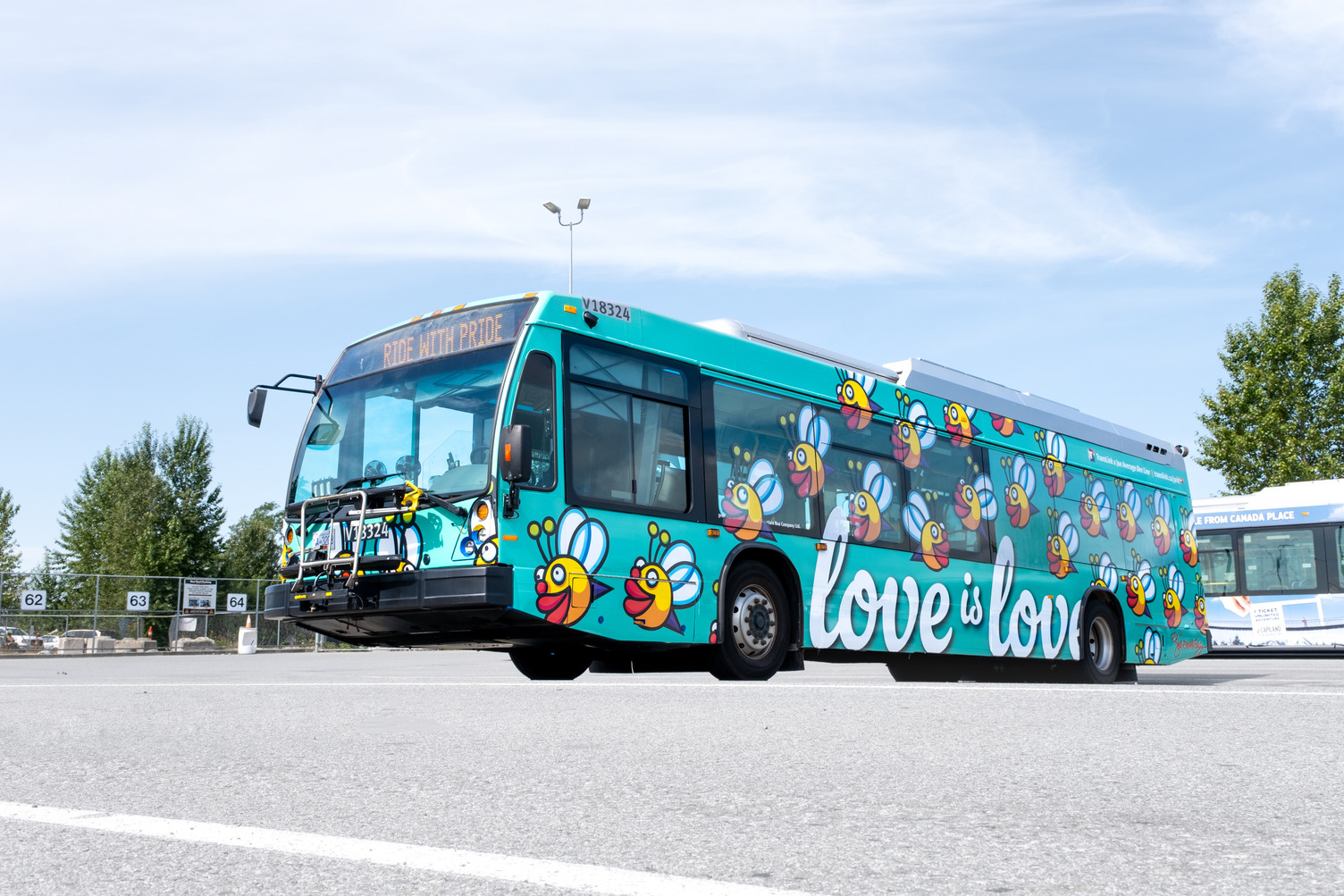
Celebrating Vancouver Pride, this bus spreads the message that “love is love”
Artist Credit: Joe Average
Photo Credit: TransLink
Public art doesn’t have to be stationary art: from subway trains to buses, public transit can take installations along for a ride. One way to use a vehicle as a canvas is through wrapping, which involves covering the exterior with vinyl or some other printed material. While bus wrapping is frequently used for advertising purposes, it also serves as a method for creating temporary public art for a city-wide audience.
At TransLink, Metro Vancouver’s public transportation network, visually stunning bus wraps highlight the diverse heritage and flourishing arts scene of the region. These temporary public art buses often observe important cultural events for the local community, such as TransLink’s 2023 PrideBus, which featured bus wrap artwork by iconic local artist Joe Average, whose banners are a staple of Vancouver’s queer enclave Davie Village. In 2024, for the celebration of Vaisakhi, Punjabi artist Jag Nagra created a vibrant bus wrap spotlighting Sikh culture and community—a defining part of Metro Vancouver’s cultural fabric.
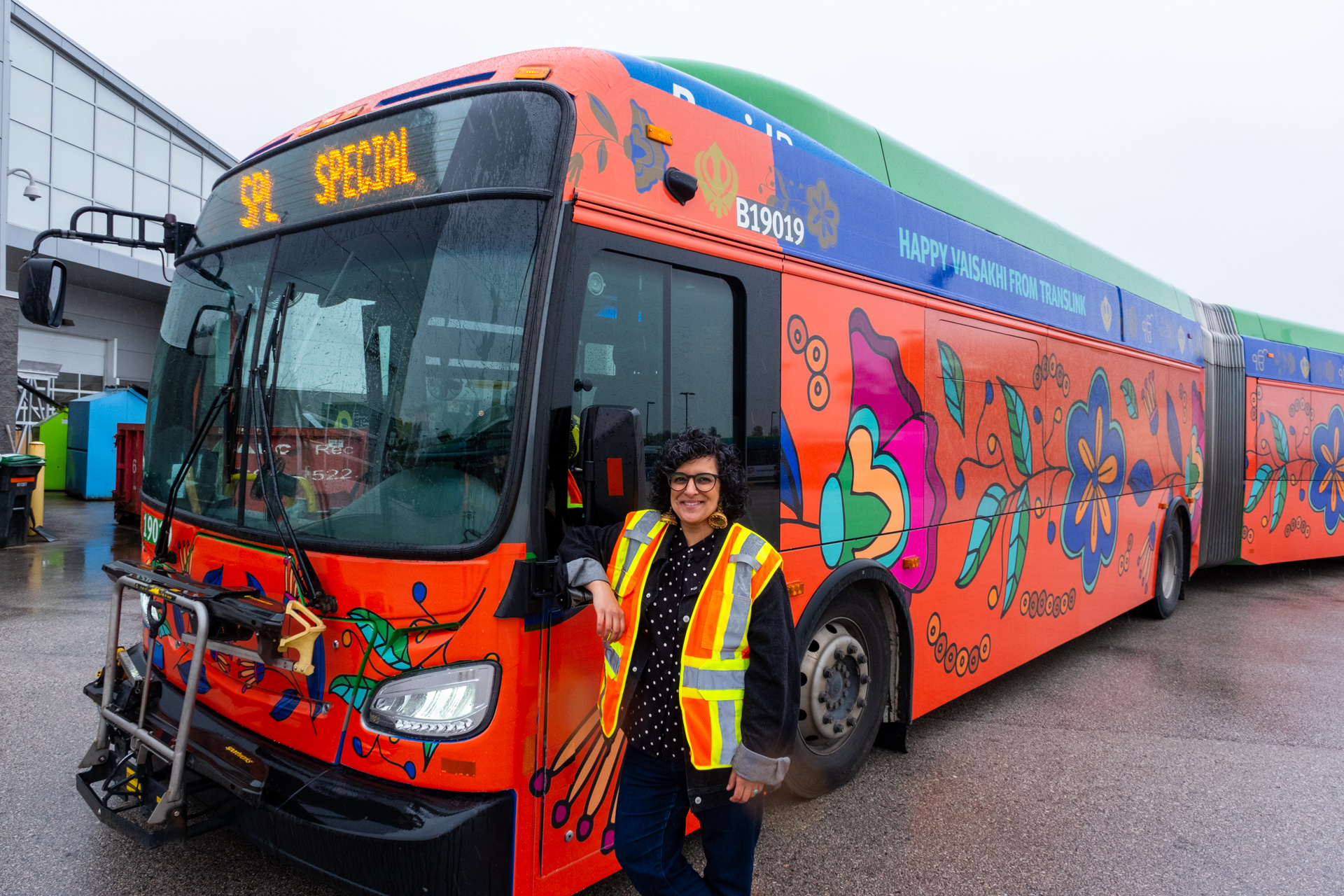
This Sikh-textile-inspired bus wrap drives out for 2024 Vaisakhi
Artist Credit: Jag Nagra
Photo Credit: TransLink
Art can be found just as much in the interior of the bus as wrapped around the exterior. Indeed, the art of poetry has found its way into subway trains and buses across the country. On Toronto’s TTC, Poems In Passage is a project amplifying diverse voices in the literary arts through transit mediums such as interior overhead advertising space. Poetry In Transit is a similar project in Vancouver by Read Local BC, which focuses on highlighting BC poets. Whether it’s visual or literary, public art is perfect for bringing colour and variety to the commute.
Taking Flight: Airport Installations
As the first and last thing that many visitors see of a new locale, the airport as an art gallery can create a bold and lasting impression of place upon both locals and tourists. One iconic airport art collection can be found at the Vancouver International Airport (YVR), home to a wide range of iconic works representing the culture of British Columbia.
A centrepiece of the YVR’s collection is The Spirit of Haida Gwaii, the Jade Canoe, a bronze sculpture by the celebrated late Haida artist Bill Reid, found in the international terminal of the airport. Teeming with creatures and figures drawn from Haida oral tradition, the piece displays to visitors one aspect of the rich Indigenous cultures of the Pacific Northwest.
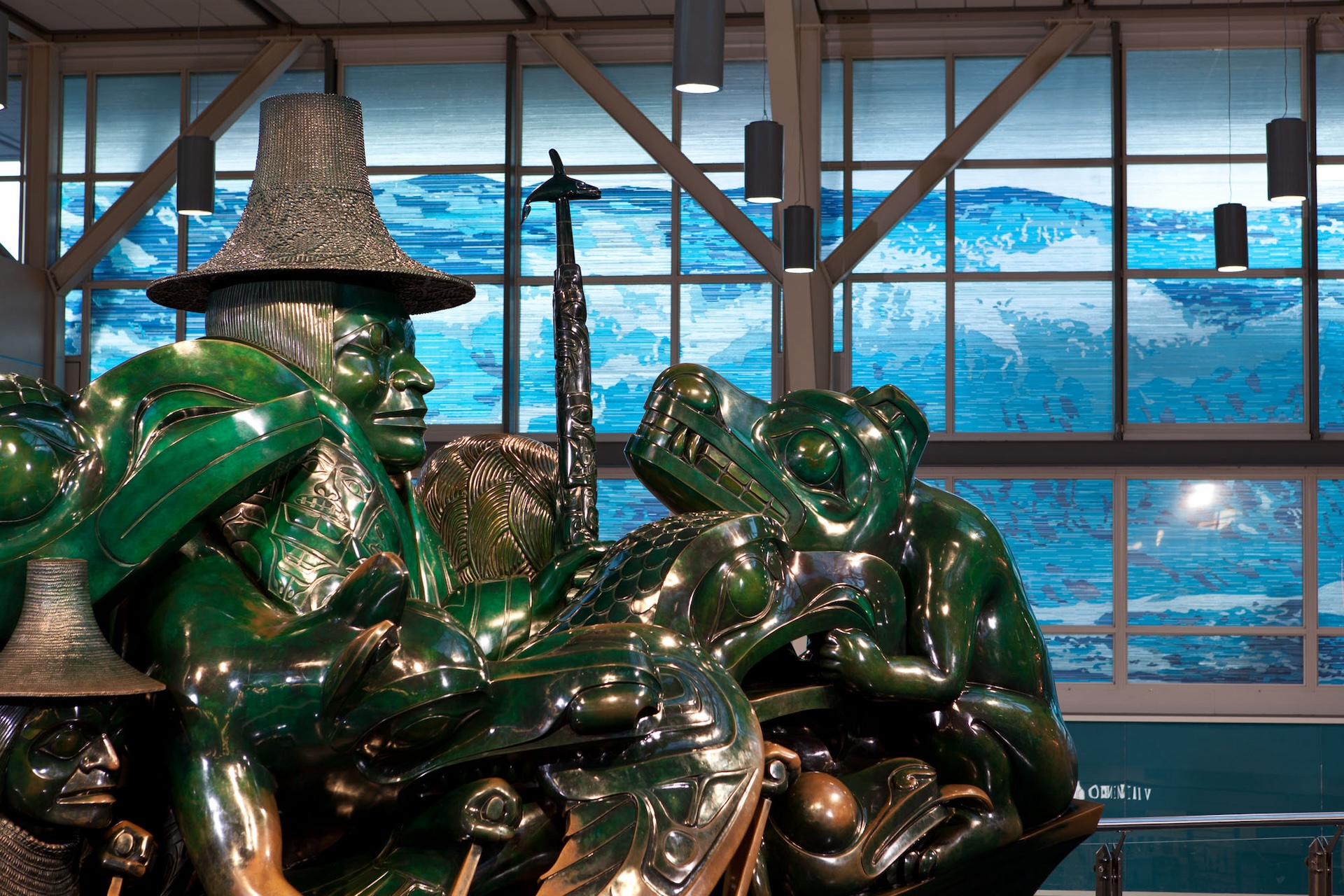
The Spirit of Haida Gwaii, the Jade Canoe watches over the YVR’s international terminal
Photo Credit: Vancouver International Airport/L’aéroport international de Vancouver
Also in British Columbia, one airport is using art to highlight the history and heritage of the lands upon which it stands. In February 2024, Xatśūll First Nation and Williams Lake First Nation, working in partnership with the City of Williams Lake and STEPS Public Art, invited artists from across the country to compete in a national competition to design a permanent public artwork for installation at the Williams Lake Regional Airport.
To be installed near the arrival gate, the three-dimensional sculptural piece will celebrate the beauty of the natural environment of the British Columbia interior and represent unity and harmony, while reflecting both Xatśūll First Nation and Williams Lake First Nation. This piece will provide an artistic focal point for new arrivals and long-term residents, revitalizing this regionally crucial transportation hub.
While airports house many pieces that would also look at home in an art gallery, their complex structure and expansive size also provide for a wide array of alternative public art designs. By integrating art into the particular architectural structures of air travel, artists can create unique works that can only be experienced at an airport.
Located at the Edmonton International Airport (YEG), The Raven {Bringer of Light} Placing the Sun into the Daytime Sky by Michael Hayden is a 3,500-pound suspended installation composed of 36 triangulated six-foot-long holographically-treated pieces. Reflecting and diffracting light in iridescent shades, The Raven is a monumental and elegant sculpture that uses the open spaces and natural light of the Canada Arrivals Hall to their full potential.
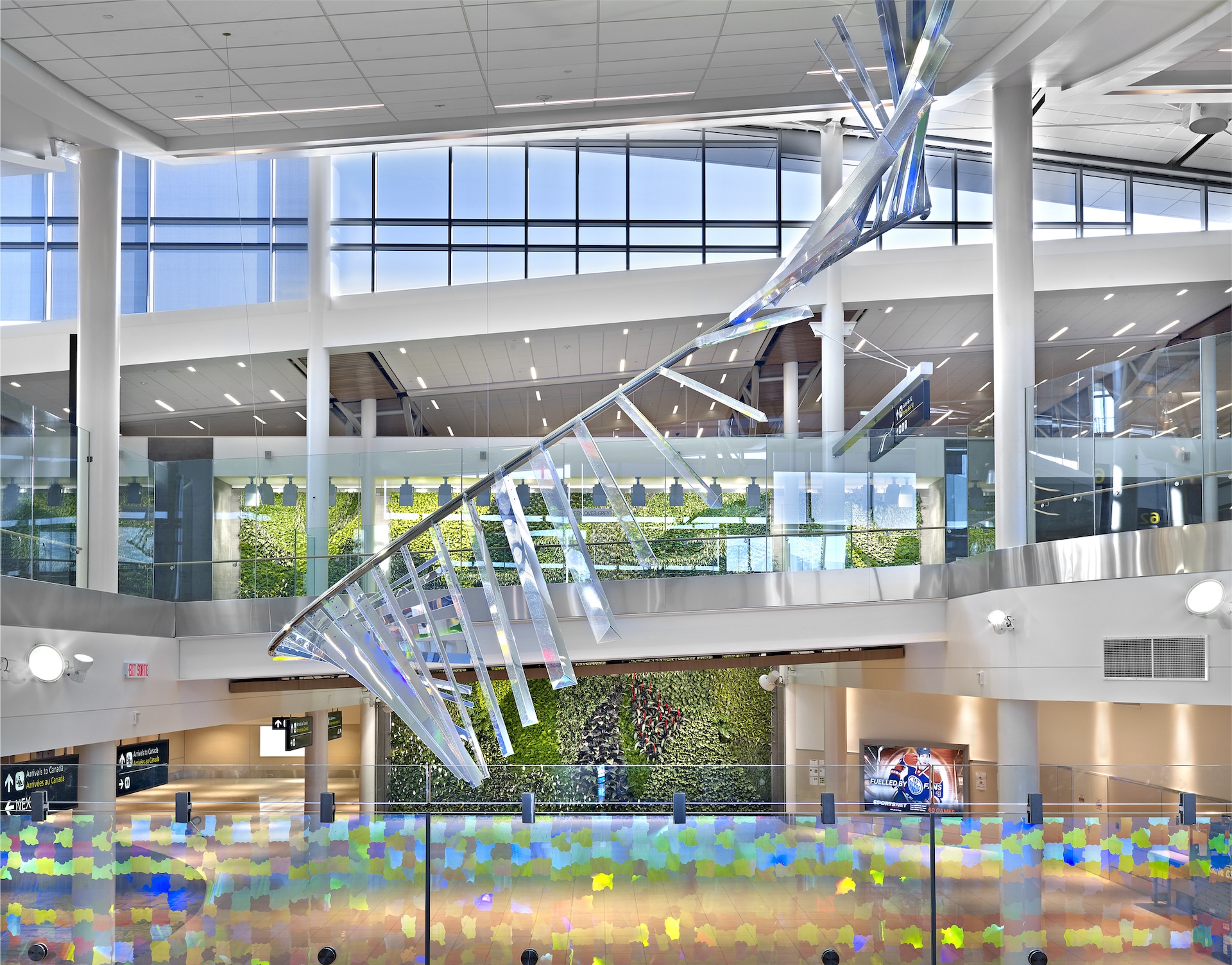
The Raven suspended against the backdrop of a living green wall, washed in natural light
Photo Credit: Merle Prosofsky
Viewable from the hall’s ground level, first floor, and interstitial walkway, The Raven presents unique visual experiences depending on your vantage point, providing visitors with a sight to remember. From arrivals to departures, public art installations like The Raven can change the way we experience air travel, enriching every airport with a fresh sense of discovery.
Off the Beaten Path: Rural Art on the Trail
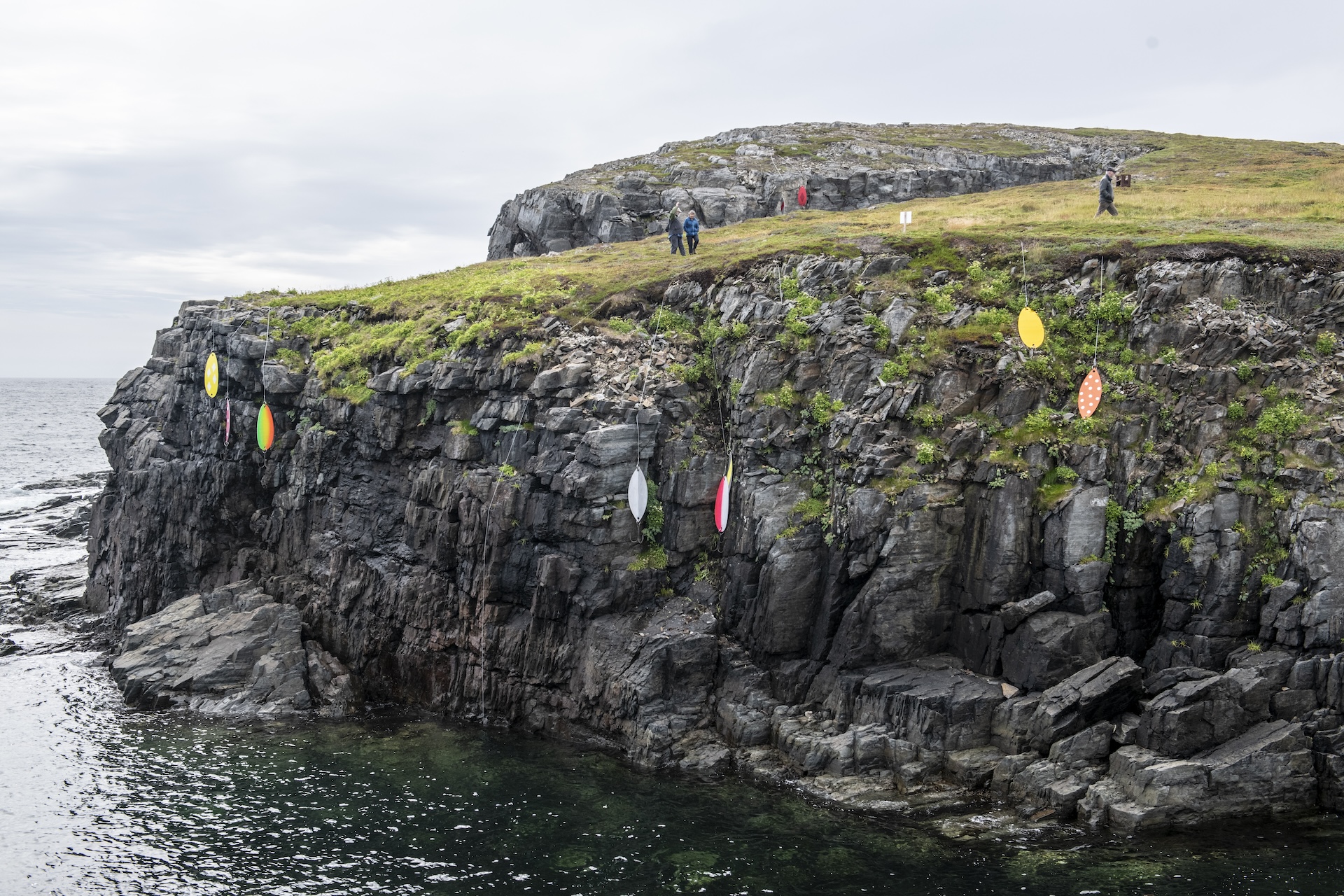
Couzyn van Heuvelen’s Nitsiit installation suspends cliff-side during the 2023 Bonavista Biennale
Photo Credit: Brian Ricks
While art on the commute usually brings to mind city streets and train tracks, rural roadways are a uniquely fitting venue for public art, combining man-made beauty with idyllic landscapes. Along Newfoundland’s east coast, Bonavista Peninsula comes alive every two years with an enchanting trail of contemporary art—with the fifth anniversary iteration set to exhibit from August 16 to September 14, 2025.
Stretching a 165-kilometre route, the Bonavista Biennale is a rural-based public art event first held in 2017. As a former centre of the Atlantic fishing industry, the Bonavista Peninsula was heavily affected by the collapse of Northern Cod populations in 1992. The Biennale, which was conceived as a part of recovery efforts for the region, serves as both arts enrichment and rural economic revitalization, bringing cultural tourism and spending to the peninsula.
From the cliffside Maberly Lookout to a Salvation Army citadel, the Bonavista Biennale uses regional locales to their full potential, combining public art with the experience of naturally beautiful or culturally significant sites. At Maberly Lookout during the 2023 Biennale, Inuk sculptor Couzyn van Heuvelen’s Nitsiit, a series of large-scale sculptural fishing lures, was suspended against the rugged rock formations of the cliff face.

Artist Credit: Wally Dion
Photo Credit: Brian Ricks
Elsewhere in a salt shed of the Ryan Premises National Historic Site, Wally Dion’s ethereal series of translucent quilts hung against a backdrop of rustic wood interiors, natural and artificial light playing off of the reflective textile surfaces. With over 20 unique and inventive sites in its 2023 iteration, the Biennale is an inspiring model of the synergy between public art and rural landscapes.
The Next Train to Arrive: Future Routes
From the airport to the subway station to the very roads on which we walk or drive, public art can transform commutes into tapestries of artistic thriving and community celebration. Beyond these five public art stops, what transportation hubs and routes remain unexplored canvases?
Keep an eye out for public art on your next commute, let your imagination drive wild, and reach out to us to collaborate on your next artistic vision.
About the Writer
Wenying Wu (she/her) is a student of English and Chinese literature beginning her MA in Comparative Literature at the University of Toronto in September of 2024. Her research interests include science fiction, body horror, and the representation of dreams. Wenying was the Cultural Content Writer at STEPS during the 2024 summer season.


